109 - Basic Principles of Radiation Therapy in Carcinoma of the Lung
Editors: Shields, Thomas W.; LoCicero, Joseph; Ponn, Ronald B.; Rusch, Valerie W.
Title: General Thoracic Surgery, 6th Edition
Copyright 2005 Lippincott Williams & Wilkins
> Table of Contents > Volume II > The Esophagus > Section XIX - Physiology > Chapter 126 - Esophageal pH Studies in Esophageal Disease
Chapter 126
Esophageal pH Studies in Esophageal Disease
Steven R. DeMeester
Tom R. DeMeester
TWENTY-FOUR-HOUR ESOPHAGEAL PH MONITORING AND GASTROESOPHAGEAL REFLUX
DIAGNOSIS OF GASTROESOPHAGEAL REFLUX DISEASE
Gastroesophageal reflux disease (gerd), defined as increased esophageal exposure to refluxed gastric juice, is a common disorder in the United States. Although the definition of GERD is straightforward, the diagnosis is not. Classic symptoms of GERD include heartburn and regurgitation; however, disorders such as achalasia, cholelithiasis, gastritis, gastric or duodenal ulcer, and coronary artery disease all can produce symptoms that mimic GERD. Costantini and colleagues (1993) have shown that GERD can be objectively demonstrated in only about 60% of patients with typical symptoms. Even more difficult are the atypical or extraesophageal symptoms of reflux, including chest pain, hoarseness, recurrent sore throat, dental caries, bronchospasm, wheezing, chronic cough, or recurrent chest infections. Consequently, the diagnosis of GERD on the basis of symptoms alone is neither sensitive nor specific.
Another approach to diagnose GERD is to identify reflux with scintiscanning or barium radiography, or to reproduce the symptoms with an acid-perfusion or Bernstein test. These tests, along with standard acid reflux testing, lack sensitivity. Endoscopy is commonly performed in patients with reflux symptoms, and although the presence of erosive esophagitis is quite specific, it also lacks sensitivity. Many patients with GERD, especially those with respiratory manifestations, do not have esophagitis. With the introduction of potent acid-suppressing medications, another common practice is to treat patients with reflux symptoms with a proton pump inhibitor; if the symptoms improve, a presumptive diagnosis of GERD is made. However, making a diagnosis based on response to therapy violates the adage in medicine that diagnosis should precede therapy and may lead to overuse of expensive medications for a variety of nonreflux problems.
Alternatively, GERD can be diagnosed by documenting increased esophageal exposure to gastric juice with ambulatory 24-hour pH monitoring. Most individuals experience short episodes of reflux, usually after meals. However, frequent or prolonged reflux episodes and reflux episodes in the supine position are rare in normal individuals. Ambulatory 24-hour esophageal pH monitoring allows clinicians to quantitate esophageal acid exposure, define the limits of normal exposure, and diagnose reflux disease when acid exposure exceeds the upper limits of normal. Consequently, 24-hour pH monitoring has emerged as the test with the greatest sensitivity and specificity for the diagnosis of gastroesophageal reflux and is currently considered the gold standard.
Importance of 24-Hour Esophageal pH Monitoring
Antireflux surgery can only be successful to the extent that the patient's symptoms are due to reflux disease. Consequently, it is critical to confirm the diagnosis and evaluate the pathophysiologic abnormalities in a patient with GERD before attempting surgical correction. Familiarity with the nuances and pitfalls of esophageal pH monitoring and motility testing prevents misapplication of the results, facilitates patient selection, and improves patient outcome. With the introduction of laparoscopic techniques for antireflux surgery, more patients with early disease are presenting for consideration of a fundoplication. Esophagitis and findings associated with advanced disease are typically absent in these patients. It is therefore necessary to interpret carefully the results of physiologic testing to identify appropriate surgical candidates. A multivariate analysis of factors predicting outcome after laparoscopic Nissen fundoplication by Campos and colleagues (1999) at the University of Southern California found that an abnormal 24-hour pH score had the best correlation with a good outcome. Other significant predictors for a good outcome in this analysis were the presence of typical reflux symptoms and substantial symptomatic
P.1923
improvement with preoperative acid-suppression medication. Of patients with all three factors in their favor, a good to excellent outcome was achieved in 97.4%.
Ambulatory esophageal pH monitoring is also useful for evaluating patients with recurrent symptoms after antireflux surgery, those with heartburn symptoms after a myotomy for achalasia, and the efficacy of acid-suppression medication. Probes designed to measure bilirubin spectrophotometrically are useful to assess duodenogastric reflux and can help identify patients likely to develop severe mucosal injury and complications of reflux disease due to the damaging synergism of bile and acid on the squamous esophageal mucosa.
The purpose of monitoring esophageal pH is to detect an increased esophageal exposure to refluxed acidic gastric contents. It is well known that the esophagus may be the source of severe symptoms, including heartburn, dysphagia, and chest pain; however, there is great variability in the symptoms experienced by patients. Commonly, patients with severe symptoms are found endoscopically to have only mild degrees of esophagitis and inflammation, whereas other patients with severe esophagitis report only mild symptoms. It is possible that the pain of reflux is correlated with both the frequency and the concentration of refluxed acid. Smith and co-workers (1989) infused different concentrations of hydrochloric acid into 25 patients with symptoms of reflux disease and found a greater prevalence and a more rapid onset of pain as the concentration of infused acid increased. Similarly, Bremner and colleagues (1992) demonstrated that esophageal mucosal damage correlated with the concentration of refluxed acid. They compared ambulatory pH monitoring results from 154 patients with reflux disease to 50 normal subjects and demonstrated that the likelihood of mucosal injury was greatest in those with esophageal exposure to a pH of 0 to 2.
Normally, gastric pH is in the range of 1 to 2, and the intraluminal pH of the esophagus is between 4 and 7. A dip in the continuously measured esophageal pH below 4 has become the most commonly used threshold for determining a reflux episode. There are three main causes of an increased exposure of the esophagus to refluxed gastric juice:
A structurally defective lower esophageal sphincter (LES)
Inefficient esophageal clearance of refluxed gastric juice as a consequence of either low peristaltic amplitudes or an increased percentage of simultaneous or ineffective contractions in the esophageal body
Gastric abnormalities that cause delayed gastric emptying or increased gastric pressure, precipitating reflux through what otherwise might be a competent LES.
Although esophageal pH monitoring is designed to detect episodes of refluxed acid and does not identify the cause of reflux, in most cases, an experienced interpreter can gain insight into the cause by careful analysis of the 24-hour pH tracing. The most common cause of abnormal reflux is a functionally defective LES. In these patients, under conditions of stress such as a full stomach after eating, the sphincter is compromised, and reflux events occur. This is thought to be the earliest form of reflux disease, and the pH tracing typically demonstrates frequent episodes of reflux limited primarily to the postprandial period. Reflux episodes occurring primarily or exclusively in the upright position suggest early reflux disease, whereas bipositional reflux is associated with more advanced disease and usually indicates that the LES is severely impaired. Pure supine reflux is rare. Intermittent, prolonged reflux episodes on the 24-hour pH tracing suggest delayed esophageal clearance, particularly if they occur in the upright position.
Detailed analysis of the pH tracing is also important when no abnormal reflux is detected in patients with typical reflux symptoms or complications of reflux disease. Duodenal contents (composed of pancreatic and biliary secretions) are alkaline and have a pH of 6 to 8. In patients with duodenogastric reflux, the alkaline secretions may neutralize gastric acid to a pH higher than 4. Consequently, reflux episodes into the esophagus would not be detected. One clue that this might be occurring is when there is an abrupt fall in esophageal pH from a baseline of 6 to 7 to a pH between 4 and 5. If gastroduodenal reflux is suspected, a probe that measures bilirubin can be used to prove abnormal biliribin exposure and to confirm the diagnosis of gastroduoenal reflux. Recently impedance monitoring techniques have been developed. This technology allows measurement of esophageal luminal impedance changes at multiple levels and can demonstrate reflux events of both acid and nonacid when combined with a pH probe (Fig. 126-1).
Food in the stomach can also neutralize gastric acid and is another cause of a normal pH score despite typical reflux symptoms. Ter and colleagues (1997) have suggested that exclusion of meal periods from analysis of a 24-hour pH record improves the separation between patients and normal subjects and allows for a more accurate classification of patients. A third possibility for a false-negative test is probe malfunction or misplacement due to coiling. Finally, an important cause of a normal study in a patient with typical reflux symptoms is medication use, particularly proton pump inhibitors, within several days of the study. This should be detected at the time the pH probes are positioned by measuring an inappropriately high gastric pH.
Digitrappers and Computers
The earliest prolonged recordings of esophageal pH required that the patient remain in one place attached to a chart recorder throughout the study period. The chart recorders used a large amount of paper and required tedious and time-consuming manual analysis of each recording. With the advent of the personal computer, solid-state memory recorders, and analog-to-digital converters, outpatient
P.1924
P.1925
ambulatory pH monitoring over a full 24-hour period has become standard. The newest data loggers are capable of simultaneously recording esophageal pressure and pH at a sampling frequency of eight times per second, and they contain event markers that enable the patient to document meals, sleep periods, and symptomatic episodes.
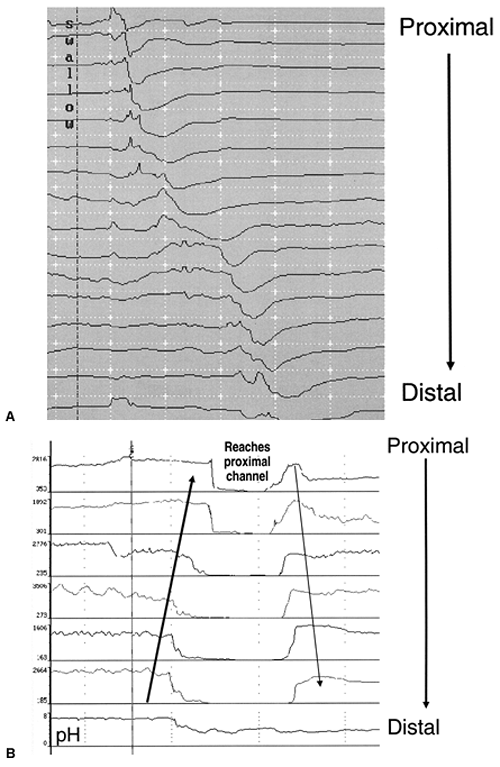 |
Fig. 126-1. A. Impedance tracing of a swallow. As the bolus moves down the esophagus, impedance decreases and then returns back toward baseline levels. The movement of the bolus in an aboral or downward fashion is easily recognized. Each box represents 2 seconds. B. In contrast to the aboral movement of a swallowed bolus, a reflux event is characterized by the orad or upward movement of a bolus from the stomach toward the proximal esophagus. The height of the reflux event can be determined, as can esophageal body clearance of the refluxed material. In this example, the reflux event reaches the proximal channel (thick arrow) and then is cleared from the esophagus (thin arrow) with a swallow. The drop in pH (lowest channel) indicates that this was an acid reflux event. |
Analysis of Data: Derivation of Gastroesophageal Score
It is important to emphasize that 24-hour esophageal pH monitoring should not be considered a test for reflux but instead a means of measuring esophageal exposure to gastric juice. To define abnormal exposure, normal exposure was first determined in a group of asymptomatic volunteers. Analysis of these pH tracings allowed calculation of the time that esophageal pH was less than 4. However, this value did not reflect how the exposure occurred (i.e., whether it occurred as a single long episode or multiple short episodes) (Fig. 126-2). Therefore, to characterize esophageal acid exposure fully, it is necessary to know the number of times that esophageal pH drops below 4 and the duration of each episode. A problem with these parameters is that esophageal pH can fluctuate just above and below 4 after a reflux episode (Fig. 126-3). In our opinion, a reflux episode ends when the pH rises above 4 for the first time. This method allows for the most accurate means of measuring the frequency and duration of reflux episodes.
In 1974, Johnson and one of us (TRD) chose to report the results of 24-hour pH monitoring in the following manner: (a) cumulative reflux time, expressed as the percentage of total monitored time, percentage of time monitored upright, and percentage of time monitored supine; (b) frequency of reflux episodes, expressed as the number of reflux episodes per 24 hours; and (c) duration of reflux episodes, expressed as the number of episodes longer than 5 minutes and the length in minutes of the longest episode. This report identified six components of a 24-hour pH record that could be specifically analyzed (Table 126-1). Significantly, when normal values for these six components were compared among three major centers in the United States and various centers throughout the Western world, there was an unexpected uniformity of results. This would indicate that esophageal acid exposure can be quantified, and that in normal
P.1926
individuals, it is similar despite ethnic and dietary differences (Table 126-2).
 |
Fig. 126-2. The pH tracings (A, B) demonstrate how the nature of esophageal exposure to acid reflux differs in different patients and how the pH tracing can be used to gain insight into the pathophysiology of reflux disease in a patient. The multiple short reflux episodes to pH less than 4 (A) are characteristic of a defective lower esophageal sphincter, whereas prolonged episodes (B) suggest poor esophageal clearance. |
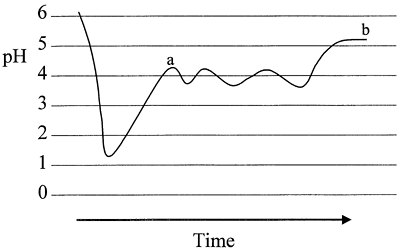 |
Fig. 126-3. This mock pH tracing illustrates the difficulty with measuring the duration of a reflux episode. The episode can either be interpreted as ending at point a, where the pH rises above 4 for the first time, or point b, after the pH has stayed above 4 for a set period. Using point a as the end of the reflux episode allows for the most precise and unbiased determination of the duration of a reflux episode. |
Table 126-1. Esophageal Acid Exposure in 50 Healthy Volunteers | |||||||||||||||||||||||||||||||||||||||||||||||||||||||||||||||
|---|---|---|---|---|---|---|---|---|---|---|---|---|---|---|---|---|---|---|---|---|---|---|---|---|---|---|---|---|---|---|---|---|---|---|---|---|---|---|---|---|---|---|---|---|---|---|---|---|---|---|---|---|---|---|---|---|---|---|---|---|---|---|---|
| |||||||||||||||||||||||||||||||||||||||||||||||||||||||||||||||
During the initial analysis of 24-hour esophageal pH records obtained from patients with typical symptoms of gastroesophageal reflux, it was noted that not all six components were abnormal in each patient. Therefore, in patients who had a mixture of normal and abnormal components, some means of assessing the relative significance of each component of analysis was necessary to make an overall determination of whether the patient had abnormal esophageal exposure to acid. A scoring system based on the standard deviation from the mean for each of the six components, as measured in 50 normal subjects, solved this problem. Bremner and colleagues (1995) described the final formula and its derivation in detail. The scoring system provides a method of weighing the significance of each of the six components based on the reliability of each component. For example, in the normal volunteers, the number of reflux episodes in 24 hours was highly variable and had a large standard deviation. Thus, in the scoring system, relatively few points are awarded for this component. In contrast, normal subjects rarely reflux at night. Consequently, the standard deviation for this component is small, and more significance is given to it in the scoring system. Another advantage of the scoring system, noted by Richter and associates (1992), is that it is not specific to sex. Studies have demonstrated that men have more physiologic reflux than women; thus, if the percentage of time less than pH 4 is used as the sole criterion for identifying abnormal acid exposure, sex must be taken into account. This is factored out of the formula.
Currently, an IBM-compatible computer program reads pH records and expresses the data as the percentage of time the esophageal pH is less than 1, 2, 3, and 4 or more than 7 and 8. The number of reflux episodes, the number of episodes lasting longer than 5 minutes, and the length of the longest episode are measured at each pH threshold. The data for each individual component as well as a composite score calculated from all six components can be graphically displayed (Fig. 126-4). Typically, increased esophageal exposure to pH less than 4 is used to define the presence of abnormal reflux.
Table 126-2. Normal Values for Six Components of pH Values from Three Different Centers in the United States; Data Expressed as Median and Range | ||||||||||||||||||||||||||||||||||||||||
|---|---|---|---|---|---|---|---|---|---|---|---|---|---|---|---|---|---|---|---|---|---|---|---|---|---|---|---|---|---|---|---|---|---|---|---|---|---|---|---|---|
| ||||||||||||||||||||||||||||||||||||||||
Performance of the Study
It is important to standardize the test so that it is performed the same way in all patients. Patients should be encouraged to be as active as they normally are during the study. All medications that affect the pH of the stomach or the motility of the foregut should be stopped before the study. It is debated how long patients should be off proton pump inhibitors, such as omeprazole, because this medication theoretically irreversibly blocks the proton pump of a parietal cell. In reality, this is probably not the case. It is unclear, however, how long it takes for gastric secretion to return to normal after cessation of therapy. In 1992, Marks and co-workers reported that even 4 weeks after cessation of proton pump inhibitors, some patients still have suppressed basal and mean acid output. Others have suggested that clearance typically occurs much more rapidly, often within 48 hours. Our policy is to ask patients to stop proton pump inhibitors 2 weeks before the study. This interval is difficult for many patients with severe reflux symptoms; however, they must understand that even one dose of a proton pump inhibitor can result in a false-negative test. We
P.1927
allow substitution of an H2-receptor antagonist up to 48 hours before the study, and antacids may be used until the night before the study. Medications that promote gastrointestinal motility are discontinued at least 48 hours before the study. Furthermore, every effort is made to eliminate medications, such as psychiatric drugs, that have as a side effect impairment of gastrointestinal motility.
Catheter and Catheterless Systems
Traditionally, the 24-hour pH study is performed with a catheter passed down the nose that is left in place for the duration of the study. However, even thought the catether is small, some patients have difficulty tolerating it for the entire 24-hour period, and nearly all patients experience some degree of social embarrassement associated with wearing the catheter in public. This may lead to alterations in a patient's normal routine that can produce a false-negative test in some cirumstances. Consequently, a new catheterless system has been developed and is beginning to be used clinically. Called the Bravo probe, this system uses a capsule containing the pH probe, a tranmitter, and a battery, all in a small device that is attached to the esophageal mucosa with a special pin (Fig. 126-5). The device transmits pH data to a storage device worn on the belt. Generally, the capsule falls off after several days and is passed out the gastrointestinal tract. By eliminating the transnasal catheter, this system improves social acceptablity (no one even knows that a pH study is in progress), eliminates the oropharyngeal discomfort associated with a catheter, and hopefully will improve patient compliance and acceptance of the study (Fig. 126-6).
24-Hour pH Test Period
Patients are asked to keep a diary during the 24-hour pH study and to document meal periods as well as any symptoms they experience. Only water is allowed between meals, and any episodes of water drinking should be written in the diary. Carbonated beverages are forbidden because they have an acidic pH, and the carbonation may cause belching. Patients are encouraged to eat normal-sized meals during the study, although they may be unable or unwilling to do so. To account for variations in eating patterns with the probes in place, we have tried to standardize one of the meals. Each patient is asked to eat a hamburger, french fries, and a milkshake from a fast-food restaurant. Patients are asked to eat all of the meal if possible and to record the percentage actually eaten in their diary. The other meals are the patient's choice. During the monitoring period, patients are asked to sleep only at night. Furthermore, the time of retiring to bed is noted in the diary. Although it is important to evaluate the patient in the most physiologic conditions possible, it is probably prudent to avoid conditions that are known to exacerbate reflux and therefore may influence the results of the study. Such conditions include vigorous exercise, alcohol drinking, or cigarette smoking.
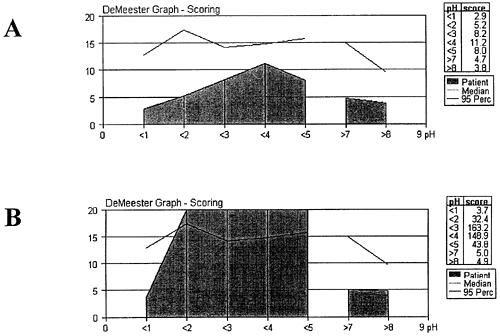 |
Fig. 126-4. Graphic display of the composite score used to express the overall result of a 24-hour esophageal pH recording. The lower line represents the median score and the upper line the ninety-fifth percentile from 50 normal subjects. The black area represents the composite score at each pH for the patient. To the right of the graph, the actual score at each pH is printed. In (A), the composite score is normal, whereas in (B), it is elevated at pH 2 to 5. Note that, graphically, the score ends at 20, but as shown on the right of the graph, this patient's score at pH less than 4 is markedly elevated (148.9). |
The 24-hour test period was chosen because it records reflux events over one complete circadian cycle. Limiting the monitoring period to a shorter length of time reduces the opportunity to correlate symptoms with reflux episodes and is complicated by the necessity for the patient to actually sleep and not just assume the supine position. Provided that the patients were able to sleep, Walther and one of us (TRD, 1985) demonstrated that 8 hours of monitoring divided into upright and supine periods correlated closely with the results of a full 24-hour study.
Electrodes and Determination of Hydrogen Ion Concentration
The logarithmic relationship between pH and hydrogen ion concentration was described in the early 1900s. Mathematically, it is expressed as pH = +log(1/[H+]). Thus, a solution with a pH of 1 contains 10 times the hydrogen ion concentration of a solution at pH 2, and 1 million times the
P.1928
concentration of hydrogen ions at pH 7. At pH 7, the concentrations of hydrogen and hydroxyl ions are equal, and the solution is considered neutral. Hydrogen ion concentration or pH can be measured by several different electrodes, each of which has different characteristics, depending on the material from which they are made. The ideal probe to measure esophageal pH over 24 hours would have the following characteristics: (a) it would be small, so that it can be passed atraumatically through the nose into the esophagus or stomach; (b) it would be firm enough so that it remains in the same position for the entire duration of the study; (c) it would have a rapid response from pH 1 to 7; (d) it would be minimally affected by temperature; (e) it would have no hysteresis effect; (f) it would exhibit no drift; (g) it would be inexpensive; (h) it would be simple to calibrate; and (i) it would be either disposable to avoid transmission of infectious agents or sterilizable, durable, and reliable for the life of the electrode. The ideal probe does not exist.
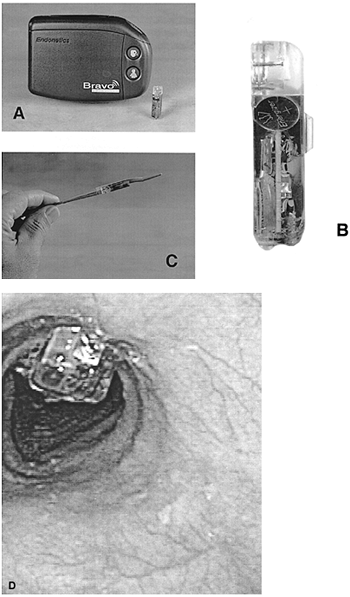 |
Fig. 126-5. The Bravo probe system is a catheterless ambulatory pH monitoring system. A. With this system, pH data are transmitted to a data recorder by a capsule attached to the esophageal mucosa 5 cm proximal to the upper border of the LES. B. The capsule is a self-contained pH probe, transmitter, and battery. C. The capsule is placed using an introducer that can be passed transnasally or transorally. D. Once at the appropriate position in the esophagus, suction is applied to draw mucosa into a well in the capsule, a pin is fired through the mucosa, and the introducer is withdrawn, leaving the capsule attached to the esophagus, as shown in this endoscopic picture. After several days, the capsule falls off and is passed out the gastrointestinal tract. There is no need to recover the capsule because the pH data are transmitted to the data recorder for the life of the battery (48 72 hours). With this system, often 48 or more hours of pH data are obtained, and this can be helpful in some patients. |
The two probes most commonly used in clinical practice are made of glass or of antimony, although small disposable plastic electrodes may become more popular in the future. Glass electrodes measure the electrical potential set up by a concentration gradient of hydrogen ions across a thin glass membrane. This potential is measured with respect to a reference electrode that may either be placed on the surface of the skin or contained in the same assembly as the glass
P.1929
membrane. Internal reference electrodes are preferred because they are more reliable and convenient. The electrical potential difference set up by the concentration gradient of hydrogen ions between the measuring and reference electrodes can be extrapolated using Nernst's equation to give a pH value. One pH unit is about equal to a 62-mV potential difference between the electrodes. Glass electrodes have been shown to have a linear response to pH changes from 1 to 12 and to be minimally affected by temperature. A disadvantage of glass reference electrodes is that they must be continuously soaked in a saturated solution of potassium chloride; if allowed to dry out, they become useless.
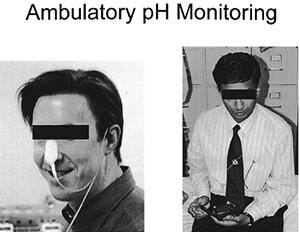 |
Fig. 126-6. Both subjects in the picture are undergoing an ambulatory pH monitoring study. Without the transnasal pH catheter in place, patients undergoing a Bravo pH study are spared the social embarrassment and are more likely to carry out their typical routine, perhaps leading to a more valid study of their typical esophageal acid exposure. |
Antimony probes measure pH based on the corrosion potential that develops at the hydrogen ion and antimony interface. Advantages of the antimony probes are that they are cheaper than glass and more capable of miniaturization. Although a smaller probe is likely more comfortable for the patient, there is concern that these small electrode tips have a greater tendency to be surrounded by esophageal mucosal folds and thereby may be excluded from refluxed gastric contents. Disadvantages of antimony probes include the need for an external reference electrode, a limited life span, temperature dependence, and a marked hysteresis effect. Furthermore, these probes lose their linear relationship with hydrogen pH above 7 and are not useful in the diagnosis of alkaline reflux. It is imperative to recognize that many commercially available buffer solutions contain phosphate, and phosphate forms complex ligands with antimony. Thus, an inorganic buffer solution must be used to calibrate antimony probes.
In 1991, Duroux and colleagues described the ion-sensitive field-effect transistor. This plastic electrode, which contains a hydrogen ion sensing surface and a signal amplifier in a single device, has a theoretic advantage over other electrodes in that it can be made cheaply enough to be disposable. Furthermore, the response time, sensitivity, and 24-hour drift of these electrodes are similar to those of glass electrodes. Their ultimate role in clinical practice remains to be seen.
Calibration of Electrodes
Before each pH study, the electrodes must be calibrated correctly because small errors in calibration can lead to grossly inaccurate results. The probes should be calibrated in standard solutions at pH 1, 4, and 7. Probes are usually calibrated at room temperature, but the pH of a solution changes with increasing temperature. Therefore, a correction factor must be incorporated either in the Digitrapper itself or in the computer program used for analysis. At the beginning and end of the study, the catheter should be advanced into the stomach to record the gastric pH. Lack of an acidic gastric pH, as in patients with achlorhydria or recent use of acid-suppression medication, invalidates the study. The probes should always be calibrated in the same pH solutions at the conclusion of the study to identify any drift that may have occurred over the recording period. Studies that have an electrode drift of greater than 0.2 pH units should be discarded and the test repeated.
Placement of the pH Probes
Proper positioning of the pH electrodes requires prior manometry. For the study to accurately reflect gastroesophageal reflux, the probe must be placed 5 cm proximal to the upper border of the lower esophageal sphincter (LES). Dodds and colleagues (1974) demonstrated that with swallowing, the LES could move cephalad as much as 5 cm. Furthermore, with flexion and extension of the neck, the probe can move relative to the LES. Therefore, to exclude the possibility of the electrode advancing into the LES or stomach and being exposed directly to gastric juice, pH probes are positioned 5 cm above the upper border of the LES. Anggiansah and colleagues (1993) reported the effects of monitoring pH at 5 and 10 cm above the LES as an indication of the magnitude of error expected to occur from inaccurate placement of a pH probe. Patients with pathologic reflux had markedly diminished scores when the probe was located 10 cm above the LES compared with when it was appropriately positioned 5 cm proximal to the LES. This finding emphasizes that accurate probe placement is essential in the measurement of abnormal esophageal acid exposure and underscores our insistence on manometric LES determination. Attempts to position the probe on the basis of fluoroscopy or on pH changes as the electrode is pulled back from the stomach have been shown to be inaccurate and are not recommended.
After calibration, the probe is passed transnasally into the stomach, and gastric pH is recorded. The electrode is then
P.1930
pulled back until the distance measured at the nose correlates with the tip being positioned 5 cm above the upper border of the manometrically determined LES (Fig. 126-7). Passage of the probes through the nasal cavity is often traumatic for patients, and it is helpful to use local anesthesia with agents such as topical lidocaine jelly. Once positioned, the catheter is secured to the patient's nose to prevent migration. At the completion of the monitoring period, the catheter is dipped into the stomach to reconfirm gastric acidity, removed, and then the pH reading checked in standard solutions to assess for drift. The recording from the Digitrapper can then be downloaded and analyzed.
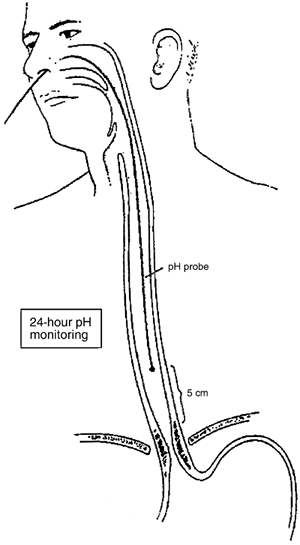 |
Fig. 126-7. Schematic illustration of the appropriate positioning of the pH electrode in the distal esophagus 5 cm above the manometrically determined upper border of the lower esophageal sphincter. |
ESOPHAGEAL PH MONITORING IN SPECIAL CIRCUMSTANCES
In several specific circumstances, 24-hour esophageal pH monitoring can be useful to assist in determining whether reflux is a potential cause of a patient's symptoms. These circumstances include patients with unexplained chest pain, recurrent pulmonary infections, adult-onset asthma, or heartburn symptoms after balloon dilatation or myotomy for achalasia and patients in whom there is the possibility of mixed acid and alkaline or bile reflux.
Unexplained Chest Pain
As many as 10% of patients with GERD have chest pain as their only symptom. Furthermore, exercise can induce reflux, and patients may present with exercise-induced chest pain that further confuses the etiology. Given the concern that heart disease is responsible for the chest pain, invariably these patients undergo an extensive cardiac evaluation before any serious consideration of esophageal etiology. In a review of 50 patients with unexplained chest pain and normal coronary angiography, one of us (TRD, 1982) and co-workers found that 23 patients had a positive 24-hour pH test for abnormal reflux. Chest pain was relieved by antireflux surgery in 10 of the 11 patients who underwent operation and in 100% of patients whose chest pain coincided with a documented reflux episode on 24-hour pH monitoring. Ghillebert and colleagues (1990) studied 50 patients with noncardiac chest pain and found that, compared with provocative testing, 24-hour pH monitoring was a more sensitive test to detect reflux as a cause for chest pain. Overall, 10% to 30% of patients who are evaluated by cardiologists for recurrent chest pain and undergo cardiac catheterization are found to have normal coronary arteries, and in about 40% of these patients, the chest pain can be traced to GERD. Patients with noncardiac chest pain tend to be younger and are more likely to be women and have other autonomic symptoms, such as tachycardia, dyspnea, dizziness, and paresthesias than are patients with chest pain caused by coronary ischemia.
Ambulatory 24-hour esophageal manometry with or without pH monitoring has also been used to facilitate the diagnosis of chest pain of esophageal origin. In addition to reflux, esophageal motor disorders can produce chest pain, perhaps as a consequence of esophageal claudication. Stein and colleagues (1991) used ambulatory motility monitoring to demonstrate that noncardiac chest pain episodes in some patients were immediately preceded by a markedly increased frequency of esophageal contractions, which were mostly simultaneous, double-peaked or multipeaked, of high (>180 mm Hg) amplitude, or prolonged duration (>7 seconds). They postulated that, similar to the heart, esophageal blood supply could be interrupted during bursts of abnormal muscular contraction. This may be particularly likely to occur in patients with nutcracker esophagus or diffuse esophageal spasm who have hypertrophic esophageal musculature. Peters and associates (1988) used ambulatory pH and motility monitoring to study 24 patients with chronic noncardiac chest pain and noted that 59% of the patients had at least one chest pain episode correlating with abnormal motility or pH. They noted that pH rather than motility abnormalities were more commonly associated
P.1931
with chest pain episodes, although 64% of episodes did not correlate with either abnormality.
Recurrent or Persistent Respiratory Symptoms
Reflux has long been recognized as a potential cause of respiratory symptoms. In 1892, Sir William Osler noted that his asthma patients would often worsen if they ate a large meal in the evening instead of at noon. In 1990, Sontag and colleagues demonstrated with 24-hour pH monitoring that 80% of asthmatics had abnormal reflux independent of bronchodilator usage. The question in any asthmatic patient is whether reflux is the cause or merely an effect of the asthma. It is unknown what percentage of the 13 to 15 million asthmatics in the United States have asthma precipitated or exacerbated by episodes of reflux, and which patients should have detailed reflux testing. However, several clinical settings have been identified that are highly suggestive of a reflux etiology for airway symptoms, and asthmatics that fit into one or more of these settings should be evaluated for reflux disease. These clinical settings include recurrent pneumonia, especially in the midlung fields; severe bronchopulmonary disease in a nonsmoker without obvious allergic triggers; and onset of bronchial asthma in late childhood or adult life. Other settings are worsened asthmatic symptoms after eating a large meal, drinking alcohol, or being in the supine position; nocturnal asthma; asthma that does not respond well to aggressive bronchodilators, including steroids; and hoarseness or sore throat with laryngoscopic evidence of redness, thickening, or scarring of the larynx.
In patients with reflux-induced asthma, three main mechanisms are potentially involved. One is microaspiration of refluxed gastric juice causing repetitive irritation and injury to the airway mucosa. A second mechanism of injury occurs through a neurogenic reflex triggered by esophageal exposure to acid. The vagus nerve has long been implicated in this reflex, but Hamamoto and colleagues (1997) demonstrated in animals that esophageal acid exposure induces release of tachykinins, including substance P, from sensory neurons. They found that these tachykinins mediate airway hyperreactivity and inflammation through vagal pathways and local axon reflexes. A third potential mechanism involves a reflexive increase in bronchomotor tone produced by reflux of gastric juice into the esophagus. In this scenario, asthma is aggravated as a consequence of increased airway responsiveness to other stimuli. There is animal or human evidence (or both) to support all three mechanisms, and it is likely that more than one is involved in many patients.
The potential association between reflux and respiratory symptoms is rarely missed in patients who present with one or more of the classic reflux symptoms (heartburn, regurgitation, or dysphagia) in addition to their respiratory complaints. However, many patients present with exclusively respiratory complaints, such as intermittent wheezing, chronic cough or throat clearing, episodes of nocturnal choking, apneic spells, hoarseness, laryngitis, or recurrent pneumonia, and in these patients, the potential association with GERD is frequently overlooked. Even with direct questioning, few patients have typical reflux symptoms. Therefore, a high index of suspicion is necessary to make the diagnosis. Furthermore, endoscopic esophagitis appears to be less common in patients with laryngeal or respiratory symptoms compared with those who present with heartburn. Consequently, determining whether refluxed gastric juice is precipitating these symptoms is best done with ambulatory 24-hour pH monitoring, preferably with dual probes.
The concept of dual-probe esophageal pH studies is that in some patients with primarily respiratory symptoms, reflux can occur as a jetlike phenomenon whereby gastric juice is shot high into the esophagus quickly. In these patients, total acid exposure in the lower esophagus may fall within a normal range, and without a proximal probe to detect reflux in the upper esophagus, the diagnosis would be missed. In normal individuals, gastric reflux into the proximal esophagus is rare. Dobhan and Castell (1993) placed dual probes in normal volunteers and demonstrated that acid exposure below pH 4 occurred at the proximal probe in less than 1% of the total time and 0% of the supine time. Using these normal data, Schnatz and associates (1996) performed a retrospective analysis of 54 patients with pulmonary symptoms suspected of being related to reflux. Patients underwent 24-hour pH monitoring with dual probes. They found that 33% of patients had abnormal reflux only into the distal esophagus, 55% had a combination of distal and proximal abnormal reflux, and 12% had abnormal reflux only in the proximal esophagus. Without using a proximal pH probe, the 12% of patients with abnormal reflux only at the proximal probe would have been missed. Donnelly and colleagues (1993), as well as Jack and co-workers (1994), have reported using simultaneous tracheal and esophageal pH monitoring to diagnose patients with respiratory symptoms caused by reflux. Tracheal pH should stay consistently above 6, and any dip below pH 6 is definitive evidence for reflux and aspiration. Others have used probes positioned in the hypopharynx rather than the trachea. Katz (1990) monitored 10 nonsmoking patients who complained of hoarseness with dual pH probes. The proximal probe was positioned 2 cm above the upper sphincter in the hypopharynx. A drop in pH to less than 4 at the proximal probe was found in 7 of the 10 patients. Three of these 7 patients had normal 24-hour acid exposure in the distal esophagus at the lower probe and would have been classified as not having reflux without the proximal probe. Of importance, these patients were upright refluxers with high-frequency, short-duration reflux episodes.
One must exercise caution, however, when excluding gastroesophageal reflux as a cause or contributing factor in patients with respiratory symptoms on the basis of one normal 24-hour pH monitoring study. Wynne and colleagues (1981) demonstrated that tracheal mucosal damage could persist for up to 1 week after an aspiration episode. Thus, intermittent aspiration episodes too infrequent to document
P.1932
in one 24-hour pH monitoring may produce chronic respiratory symptoms. Consequently, a single normal 24-hour pH study does not exclude the possibility that intermittent episodes of reflux are responsibe for the respiratory symptoms. Repeat pH monitoring may be necessary in selected patients in whom there is significant suspicion that reflux is responsible for the pulmonary complaint.
On the other hand, just documenting abnormal esophageal acid exposure on 24-hour pH monitoring in patients with only respiratory symptoms is inadequate to conclude that reflux is the cause of the respiratory symptoms. It is important to correlate the timing of respiratory symptoms with reflux episodes because we now know that although reflux can stimulate the onset of respiratory symptoms, it is also true that respiratory symptoms can precede and initiate an episode of reflux. Simultaneous ambulatory esophageal manometry and pH monitoring is one technique whereby the chronology and occurrence of reflux and respiratory symptoms can be evaluated and the primary or secondary nature of the reflux determined (Fig. 126-8). One of us (TRD, 1990) and colleagues has shown that this distinction is critical in evaluating patients with only respiratory symptoms for antireflux surgery because patients whose reflux episodes are induced by respiratory symptoms, such as cough or wheezing, will not be helped by a fundoplication. Instead, treatment of the primary respiratory disorder in these patients often not only improves their respiratory symptoms but also decreases reflux episodes. The best results with antireflux surgery have been in patients with respiratory symptoms that developed during or within 3 minutes after a reflux episode. In patients with both typical reflux symptoms and respiratory symptoms, this distinction is less critical because in most circumstances, correction of reflux with an antireflux operation elimates the reflux symptoms and improves or resolves the respiratory symptoms as well.
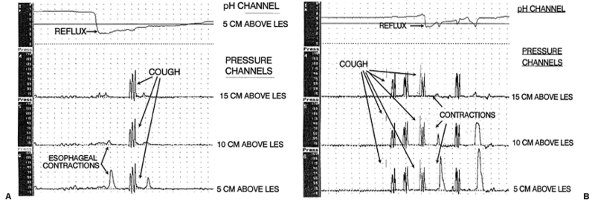 |
Fig. 126-8. Simultaneous ambulatory esophageal pH and motility monitoring allows correlation of reflux episodes and respiratory symptoms. The abrupt increase in intrathoracic pressure that occurs with coughing is recorded as a sharp spike or spikes by the intrathoracic pressure transducers. A. Coughing that occurs soon after the onset of a reflux episode may be the result of occult aspiration of refluxed gastric juice or a reflex event induced by esophageal acidification. B. In contrast, the increase in intraabdominal pressure that occurs with coughing may overcome the antireflux barrier and result in a reflux episode. When the respiratory event is primary and the reflux secondary, antireflux surgery is unlikely to significantly improve the respiratory symptoms. |
Another important factor in patients with respiratory symptoms secondary to reflux is the function of the esophageal body. One of us (TRD, 1990) and co-workers has also shown that in patients with reflux disease, there is a direct correlation between the number of respiratory symptoms and the prevalence of a motility abnormality (Fig. 126-9). Overall, 45% of patients with reflux-induced respiratory disorders were found to have abnormalities in esophageal contractility or wave progression. The dysmotility in these patients interferes with the ability of the esophagus to clear refluxed acid, particularly in the supine position, and nonperistaltic contractions facilitate the propulsion of esophageal contents retrograde up into the pharynx. As a consequence of this intermittent aspiration of swallowed saliva and food, patients with motility disorders of the esophageal body tend to have respiratory symptoms that persist after antireflux surgery.
Sontag and colleagues (1991) have speculated that aspiration of refluxed acid may initially sensitize the pulmonary tree to a variety of other stimuli and that as the process progresses, reflux and aspiration of acid become more obscure. Antireflux surgery at this stage may prevent acid-induced wheezing, but a hypersensitive pulmonary tree may still be prone to bronchospasm in response to other stimuli. Consequently, the results of ambulatory pH monitoring are not always predictive of which patients will symptomatically benefit most from antireflux surgery. The algorithm we use to make a decision for surgery in a patient with respiratory symptoms secondary to occult gastroesophageal reflux is shown in Figure 126-10.
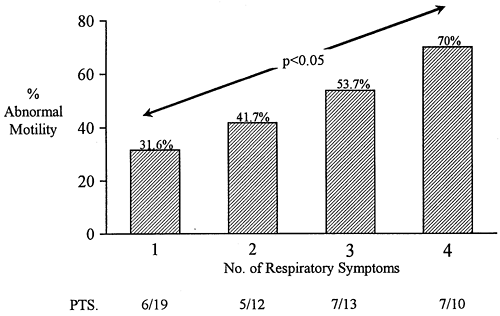 |
Fig. 126-9. Prevalence of abnormal esophageal motility (defined as > 20% abnormal esophageal contractions) in 54 patients with respiratory symptoms and increased esophageal acid exposure, stratified according to the number of reported respiratory complaints. |
P.1933
Although few requirements or contraindications are absolute for an antireflux operation, there are guidelines for which patients with respiratory symptoms are most likely to receive the greatest benefit from surgery. Table 126-3 lists characteristics of patients who are most likely to have a good outcome after a fundoplication. It is important to recognize, as reported by Richter (1996), that in contrast to heartburn symptoms, which often are promptly alleviated with proton pump inhibitors, improvement in respiratory symptoms with acid-suppression medication, if it occurs, usually is a slow process and can take up to 3 months. The same gradual improvement occurs after antireflux surgery. Spivak and colleagues (1999) reported that asthma symptom scores and medication frequency significantly decreased after fundoplication. Furthermore, 78% of patients who required steroids before surgery were able to discontinue the drug after surgery.
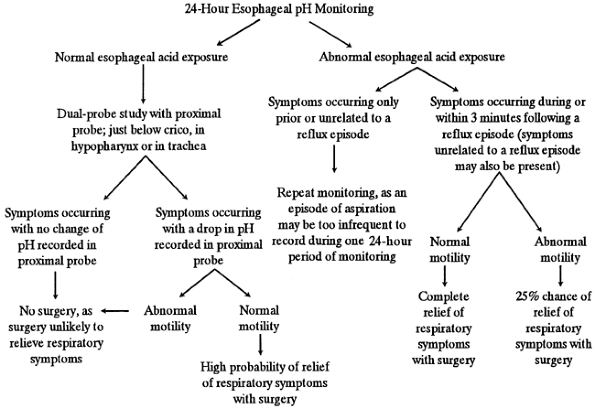 |
Fig. 126-10. Proposed management algorithm to select patients with respiratory symptoms for antireflux surgery. |
Table 126-3. Patient Factors Likely to Result in a Good Outcome after Fundoplication | |
|---|---|
|
Achalasia
Some patients with achalasia describe heartburn symptoms, but in the untreated state, heartburn is unlikely to be caused by true reflux. When these patients regurgitate, they usually describe the material as bland tasting. This would suggest that the material has not entered the stomach and that there had been no significant reflux of gastric contents into the esophagus. In patients who have been treated for achalasia, however, the situation is different. The goal of any therapy for achalasia is to lower the resting pressure and impair the function of the LES. Whether this is done by balloon dilatation or myotomy with or without an added antireflux procedure, the symptom of heartburn in these patients
P.1934
may represent reflux. In these patients, 24-hour pH monitoring has been used to discriminate between a nonspecific symptom and true reflux. However, as Crookes and colleagues (1997) pointed out, fermentation of retained food material in the esophagus can produce a slow decline in esophageal pH to less than 4. This phenomenon can usually be detected by careful analysis of the pH tracing because, rather than an abrupt drop in esophageal pH, there is a slow, steady decline (Fig. 126-11). Another means to distinguish between fermentation and reflux is to look at the percentage of time that the esophageal pH was less than 3. Crookes and colleagues found that fermentation never produced a pH less than 3, whereas all patients with sharp dips in their pH tracing (suggestive of reflux) had abnormal esophageal exposure at pH 3.
Bile
Duodenogastric reflux has been recognized as a clinical entity for many years; however, it was considered to be a rare event unless prior surgery had removed or destroyed the pylorus. Attempts to detect or diagnose duodenogastric reflux relied on the endoscopic presence of gastritis, gastric or esophageal sampling for bile salts, and nuclear medicine radionuclide scans. Duodenogastric reflux is frequently sporadic, and as a consequence, these tests lack sensitivity. Esophageal pH monitoring with glass electrodes can detect episodes of increased alkalinity (pH >7) in the esophagus; however, it cannot distinguish between the effect of swallowed saliva and refluxed alkaline gastric contents. To better clarify the origin of alkaline events in the distal esophagus, a second pH probe can be positioned in the stomach below the LES. Three patterns of simultaneous pH tracings from the two probes are recognized. Acid gastric reflux is characterized by a drop in the esophageal pH to less than 4 while the gastric pH remains less than 4. Mixed reflux refers to the situation in which the esophageal pH decreases from its baseline of about 6 to a pH of about 4 to 5 during a period when the gastric pH has risen above 4. Alkaline reflux is characterized by a rise in esophageal pH above 7 while gastric pH is greater than 4 (Fig. 126-12). Mattioli and colleagues (1990) used simultaneous probes in the esophagus, fundus, and antrum to characterize acid and alkaline duodenogastric and gastroesophageal reflux. They concluded that almost 18% of patients with abnormal alkaline gastroesophageal reflux would be considered normal based solely on standard esophageal pH monitoring. Furthermore, Fiorucci and co-workers (1992) noted that mixed reflux episodes were considerably more common in patients with severe esophagitis than in those with mild-to-moderate esophagitis or in normal subjects.
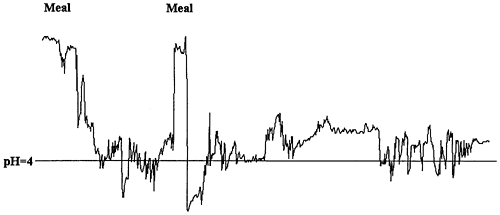 |
Fig. 126-11. A portion of a 24-hour pH tracing from a patient with achalasia. Note the slow decline in pH after the first meal period; this is characteristic of fermentation of retained food in the esophagus. After the second meal, the pH rises and drops back down to hover around pH 4. |
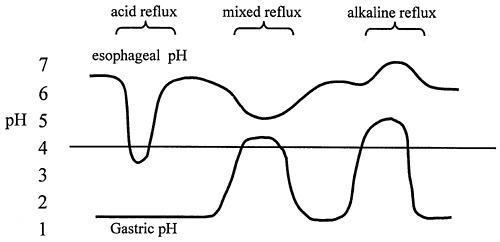 |
Fig. 126-12. Diagram of simultaneous gastric and esophageal pH monitoring to detect episodes of alkaline reflux. Acid reflux occurs when the gastric pH is less than 4 and the esophageal pH drops below 4. Mixed reflux is characterized by a decrease in baseline esophageal pH to a pH of 4 to 5, associated with an increase in gastric pH higher than 4. Alkaline reflux is characterized by an increase in esophageal pH to greater than 7 associated with an increase in gastric pH to greater than 4. |
The noxious component of duodenogastric reflux is debated, but the main contenders are bile acids; enzymes such as trypsin, lipase, and pepsin; and hydrochloride ions. Gastric sampling studies by Mattioli and colleagues (1990) demonstrated that the concentration of bile acids in the stomach progressively increases as the gastric pH rises from less than 1.5 to 3.9 and then greater than 4. Stein and colleagues (1994) corroborated the correlation between duodenogastric reflux and bile acids in the refluxed material by using a device that allows monitoring of intermittent ambulatory esophageal aspiration over a 24-hour period. However, a computerized spectrophotometer device with a fiberoptic tip that recognizes intraluminal bilirubin (the Bilitec probe) may be the most accurate and convenient method to assess duodenogastric reflux (Fig. 126-13). Studies with the Bilitec probe suggest that reflux of bile into the esophagus of normal subjects is rare but is increased in patients with GERD. Furthermore, the prevalence of gastroduodenal reflux increases in patients with complicated reflux disease (Fig. 126-14). In these patients, reflux of a mixture of pancreaticoduodenal secretions may go undetected with a standard pH probe, and consequently the Bilitec probe is helpful to indicate that abnormal reflux is occurring. Because the reflux of both acid and bile appears
P.1935
synergistic in causing mucosal damage, the use of both probes can identify patients at increased risk for complications of reflux disease. These patients are likely to be difficult to manage with medical therapy because, although proton pump inhibitors effectively reduce acid reflux events, they do not prevent alkaline reflux events (Fig. 126-15). Thus, these patients should be encouraged to have early surgical therapy.
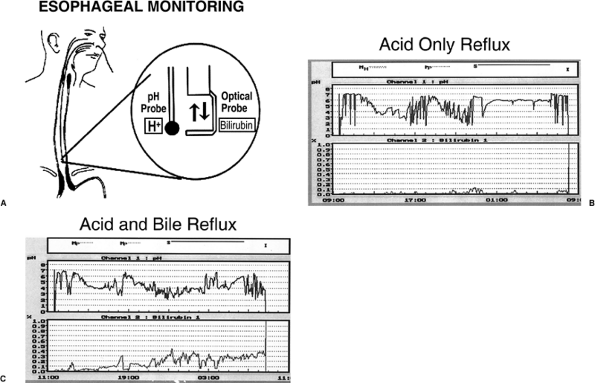 |
Fig. 126-13. A. Diagram showing positioning of pH and Bilitec probes 5 cm above the proximal border of the LES for combined pH and bilirubin monitoring. B. Tracing from combined pH and bilirubin monitoring showing multiple episodes of acid reflux to below pH 4 (top panel), but no bilirubin exposure above the 0.2% threshold (bottom panel). C: In contrast, this tracing shows both acid reflux events (top panel) and bilirubin reflux into the esophagus (bottom panel). |
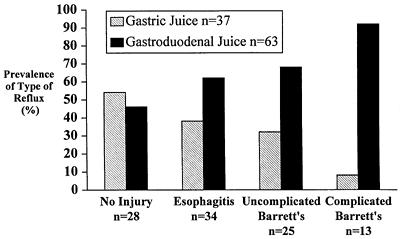 |
Fig. 126-14. Prevalence of gastric and gastroduodenal reflux in patients with either no mucosal injury, esophagitis, Barrett's esophagus, or complicated Barrett's esophagus. |
POSTOPERATIVE ASSESSMENT OF GASTROESOPHAGEAL REFLUX
Antireflux surgery is functional surgery, and it is designed to restore competency to the lower esophageal antireflux barrier by repairing a hiatal hernia and augmenting the LES. Postoperatively, patients should experience complete relief from the typical reflux symptoms of heartburn and regurgitation. If a patient experienced complete relief of preoperative heartburn and regurgitation symptoms and then suddenly noted return of the symptoms, it is quite likely that the repair has disrupted. The late onset of dysphagia after antireflux surgery suggests that the repair has migrated into the chest because of deficient hiatal closure. In the usual circumstance, however, symptomatic assessment of the success of a fundoplication is not straightforward. Some patients are hesitant to admit postoperative symptoms, whereas others tend to exaggerate them. A barium swallow is useful postoperatively to detect a misplaced
P.1936
or poorly constructed fundoplication or one that has herniated into the chest, but it provides little information about the functional success of the procedure. Because a fundoplication is designed to correct a permanently or transiently defective LES and reduce the exposure of the esophagus to refluxed gastric juice, it follows that to evaluate properly the success of the procedure, the mechanical properties of the sphincter must be measured by manometry, and esophageal acid exposure must be determined with ambulatory 24-hour pH monitoring. This may be especially important after a partial fundoplication because the augmentation of the sphincter after this procedure may be inadequate to provide complete protection from reflux. Ambulatory pH monitoring is the only reliable technique to document the presence of postoperative reflux and quantitatively compare it to the preoperative state.
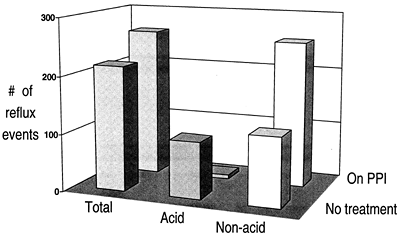 |
Fig. 126-15. Combined impedance and pH monitoring demonstrates that although proton pump inhibitor use nearly eliminates acid reflux events, the total number of reflux events is unchanged since the number of non acid reflux events increases. Modified from Vela MF, et al: Simultaneous intraesophageal impedance and pH measurement of acid and nonacid gastroesophageal reflux: effect of omeprazole. Gastroenterology 120:1599, 2001. With permission. |
REFERENCES
Anggiansah A, et al: Significantly reduced acid detection at 10 centimeters compared to 5 centimeters above lower esophageal sphincter in patients with acid reflux. Am J Gastroenterol 88:842, 1993.
Bremner RM, Bremner CG, DeMeester TR: Gastroesophageal reflux: the use of pH monitoring. Curr Prob Surg 32:429, 1995.
Bremner RM, et al: Concentration of refluxed acid and esophageal mucosal injury. Am J Surg 164:522, 1992.
Campos GMR, et al: Multivariate analysis of the factors predicting outcome after laparoscopic Nissen fundoplication. J Gastrointest Surg 3:292, 1999.
Costantini M, et al: Value of physiologic assessment of foregut symptoms in a surgical practice. Surgery 116:780, 1993.
Crookes PF, Corkill S, DeMeester TR: Gastroesophageal reflux in achalasia. When is reflux really reflux? Dig Dis Sci 42:1354, 1997.
DeMeester TR, et al: Esophageal function in patients with angina-type chest pain and normal coronary angiograms. Ann Surg 196:488, 1982.
DeMeester TR, et al: Chronic respiratory symptoms and occult gastroesophageal reflux. Ann Surg 211:337, 1990.
Dobhan R, Castell DO: Normal and abnormal proximal esophageal acid exposure: results of ambulatory dual-probe pH monitoring. Am J Gastroenterol 88:25, 1993.
Dodds WJ, et al: Effect of esophageal movement on intraluminal esophageal pressure recording. Gastroenterology 67:592, 1974.
Donnelly RJ, et al: Simultaneous tracheal and esophageal pH monitoring: investigating reflux associated asthma. Ann Thorac Surg 56:1029, 1993.
Duroux PH, et al: The ion sensitive field effect (ISFET) pH electrode: a new sensor for long-term ambulatory pH monitoring. Gut 32:240, 1991.
Fiorucci S, et al: Gastric acidity and gastroesophageal reflux patterns in patients with esophagitis. Gastroenterology 103:855, 1992.
Ghillebert G, et al: Ambulatory 24-hour intraoesophageal pH and pressure recordings of provocation tests in the diagnosis of chest pain of oesophageal origin. Gut 31:738, 1990.
Hamamoto J, et al: Esophageal stimulation by hydrochloric acid causes neurogenic inflammation in the airways of guinea pigs. J Appl Physiol 82:738, 1997.
Jack CIA, et al: Twenty-four-hour tracheal pH monitoring a simple and non-hazardous investigation. Respir Med 88:441, 1994.
Johnson LF, DeMeester TR: Twenty-four hour pH monitoring of the distal esophagus: a quantitative measure of gastroesophageal reflux. Am J Gastroenterol 62:325, 1974.
Katz PO: Ambulatory esophageal and hypopharyngeal pH monitoring in patients with hoarseness. Am J Gastroenterol 85:38, 1990.
Marks IM, et al: Duration of acid inhibition after withdrawal of omeprazole treatment in DU patients in remission. S Afr Med J 82:42A, 1992.
Mattioli S, et al: Ambulatory 24-hr pH monitoring of esophagus, fundus, and antrum. A new technique for simultaneous study of gastroesophageal and duodenogastric reflux. Dig Dis Sci 35:929, 1990.
Peters L, et al: Spontaneous noncardiac chest pain: evaluation by 24-hour ambulatory esophageal motility and pH monitoring. Gastroenterology 94:878, 1988.
Richter JE: Atypical manifestations of gastroesophageal reflux disease: pulmonary and ear, nose, and throat. Gastrointest Dis Today 5:1, 1996.
Richter JE, et al: Normal 24-hr ambulatory esophageal pH values. Influence of study center, pH electrode, age, and gender. Dig Dis Sci 37:849, 1992.
Schnatz PF, Castell JA, Castell DO: Pulmonary symptoms associated with gastroesophageal reflux: use of ambulatory pH monitoring to diagnose and to direct therapy. Am J Gastroenterol 91:1715, 1996.
Smith JL, et al: Sensitivity of the esophageal mucosa to pH in gastroesophageal reflux disease. Gastroenterology 96:683, 1989.
Sontag S, et al: Most asthmatics have gastroesophageal reflux with or without bronchodilator therapy. Gastroenterology 99:613, 1990.
Sontag SJ, O'Connell S, Khandeleval S: Antireflux surgery in asthmatics with reflux (GER) improves pulmonary symptoms and function. Dysphagia 6:62, 1991.
Spivak H, et al: Asthma and gastroesophageal reflux: fundoplication decreases need for systemic corticosteroids. J Gastrointest Surg 3:477, 1999.
Stein HJ, et al: Ambulatory 24-hour esophageal manometry in the evaluation of esophageal motor disorders and noncardiac chest pain. Surgery 110:1092, 1991.
Stein HJ, et al: Alkaline gastroesophageal reflux: assessment by ambulatory esophageal aspiration and pH monitoring. Am J Surg 167:163, 1994.
Ter RB, Johnston BT, Castell DO: Exclusion of the meal period improves the clinical reliability of esophageal pH monitoring. J Clin Gastroenterol 25:314, 1997.
Vela MF, et al. Simultaneous intraesophageal impedance and pH measurement of acid and nonacid gastroesophageal reflux: effect of omeprazole. Gastroenterology 120:1599, 2001.
Walther B, DeMeester TR: Comparison of 8- and 16-hour esophageal pH monitoring. New York: Raven Press, 1985.
Wynne JW, Ramphal R, Hood CI: Tracheal mucosal damage after aspiration. A scanning electron microscope study. Am Rev Respir Dis 124: 728, 1981.
EAN: 2147483647
Pages: 203